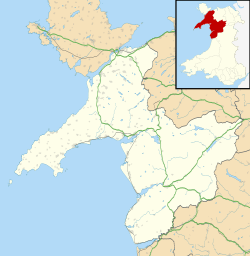Dorothea quarry facts for kids

A flooded pit in the quarry in July 2010
|
|
| Location | |
|---|---|
| Location | near Talysarn |
| County | Carnarvonshire (now Gwynedd) |
| Country | Wales, UK |
| Coordinates | 53°1′30″N 4°17′0″W / 53.02500°N 4.28333°W |
| Production | |
| Products | Slate |
| Type | Quarry |
| History | |
| Opened | 1820s |
| Closed | 1970 |
The Dorothea quarry is an old slate quarry in North Wales. It is located in the Nantlle Valley area. This large area is near the village of Talysarn. Today, it has three deep lakes that are filled with water.
Contents
History of Dorothea Quarry
How the Quarry Started
Work at the quarry started in the early 1820s. Before that, some smaller workings were on the same site. Around 1829, a man named William Turner rented the quarry. He named the workings Cloddfa Turner.
In the 1830s, the quarry was making good money. It earned about £2,000 in profits each year. Turner's son later managed the quarry. He renamed it Dorothea, likely after the landowner's wife. But by the 1840s, the quarry wasn't making as much money. In 1848, it was put up for sale.
Local People Take Over
Dorothea was the biggest quarry around. About 200 men worked there. It produced 5,000 to 6,000 tons of finished slate every year. A group of quarrymen bought Dorothea from Turner for £3,000. John Robinson, William Owen, and John Jones led this group.
They renewed the quarry's lease in 1851. The quarry was put up for sale again in 1864. At that time, it was producing 1,000 tons of slate each month. No one bought it then. Instead, John Williams from Denbighshire slowly bought shares. By 1879, he owned more than 70% of the quarry.
The quarry produced the most slate in 1872. It made 17,442 tons that year. The most profitable year was 1875, earning £14,738. In the 1930s, over 350 men worked at Dorothea. Production dropped a lot after World War II began. The quarry finally closed in 1970.
What Happened After Closing
After quarrying stopped in 1970, the Dorothea quarry filled with water. It became a popular spot for scuba diving. However, there are no special facilities for divers. Diving is also officially not allowed in the quarry. The deep water and lack of rules have led to many accidents. People are warned to be very careful if they visit.
About the Quarry Pits
The quarry is located at the bottom of the wide Nantlle valley. It has six large pits. The deepest pit goes down 106 meters from the surface. The slate in this area runs straight down. This allowed workers to dig unusually deep, vertical pits.
Because the pits go below the water table, they needed constant pumping. This kept them dry for the workers. A special Cornish engine was put in place in 1904 to pump the pits. This engine was used until 1951. Then, electric pumps took its place. The Cornish engine was the last new one ever built. It is still in its engine house today. This engine house is a Grade I listed building, meaning it's very important.
Getting Around the Quarry
The Dorothea quarry was one of the first places to use the Nantlle Railway in 1828. This railway had a special track width of 3 ft 6 in (1,067 mm). Later, the quarry built its own large system of small railways. These internal railways had a track width of 2 ft (610 mm) gauge. Dorothea was also one of the first quarries to use De Winton locomotives in 1869.
Quarry Locomotives
Here are some of the 2 ft (610 mm) gauge locomotives that worked at Dorothea:
| Name | Builder | Works No. | Date built | Type | Notes |
|---|---|---|---|---|---|
| Dorothea | Hunslet | 763 | 1901 | 0-4-0ST | This locomotive worked until 1942. You can now see it at the Launceston Steam Railway. |
| Wendy | W.G. Bagnall | 2091 | 1919 | 0-4-0ST | Wendy was bought from another quarry in 1930. It is now kept by the Hampshire Narrow Gauge Railway Trust. |


